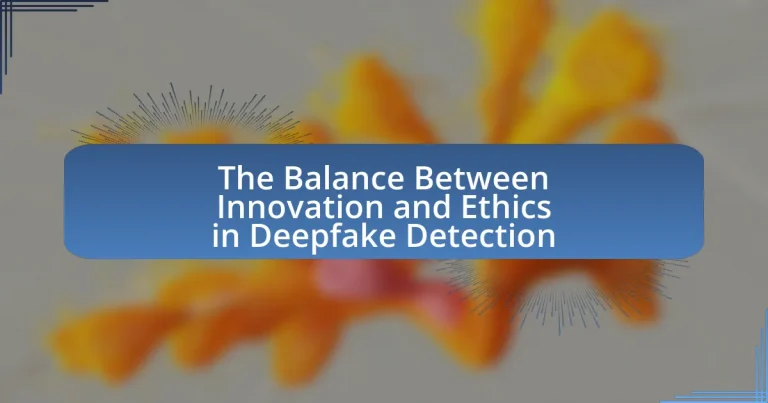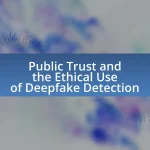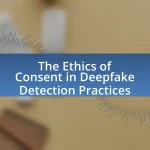The article examines the critical balance between innovation and ethics in deepfake detection technology. It highlights advancements in machine learning algorithms that enhance the identification of manipulated media while addressing ethical concerns related to privacy, consent, and potential misuse. Key discussions include the implications of deepfake technology on misinformation and public trust, the importance of ethical frameworks to guide technological development, and the challenges faced in maintaining this balance. The article emphasizes the need for transparency, accountability, and collaboration among stakeholders to ensure responsible use of detection technologies.
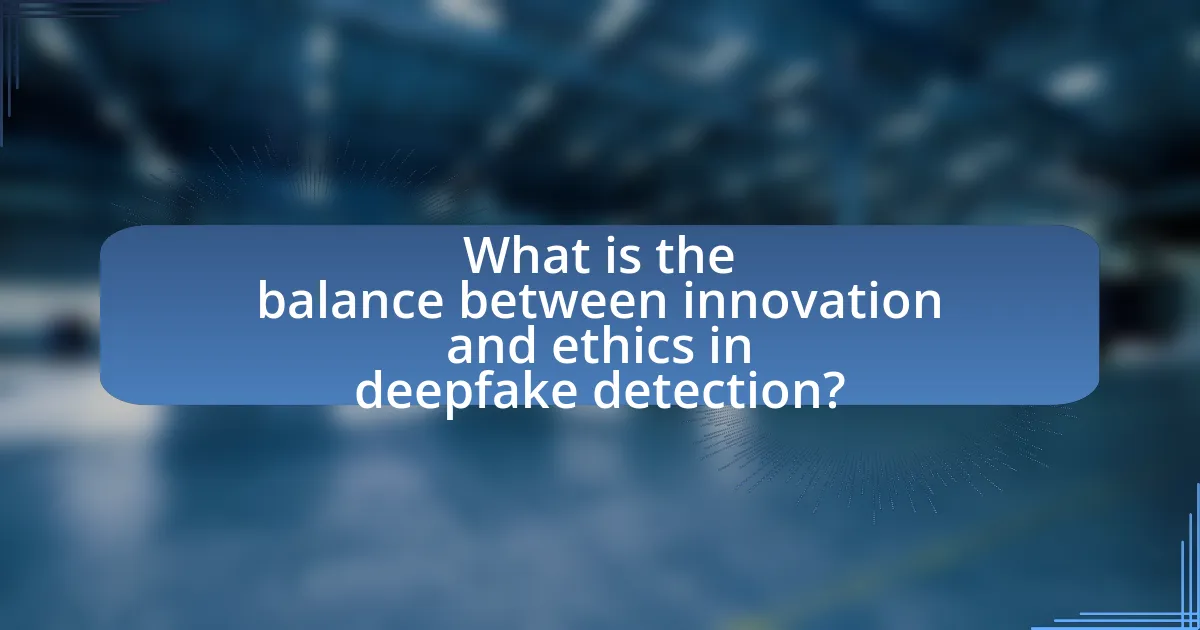
What is the balance between innovation and ethics in deepfake detection?
The balance between innovation and ethics in deepfake detection involves advancing technology while ensuring responsible use to prevent harm. Innovations in deepfake detection, such as machine learning algorithms, enhance the ability to identify manipulated media, which is crucial given the rise of misinformation. However, ethical considerations arise regarding privacy, consent, and the potential misuse of detection technologies. For instance, the development of detection tools must prioritize transparency and accountability to avoid infringing on individual rights. Research indicates that while technological advancements can improve detection accuracy, they must be accompanied by ethical guidelines to mitigate risks associated with misuse, such as surveillance or censorship.
How do innovation and ethics intersect in the context of deepfake detection?
Innovation and ethics intersect in deepfake detection by balancing technological advancements with the responsibility to prevent misuse. As deepfake technology evolves, innovative detection methods, such as machine learning algorithms, are developed to identify manipulated content effectively. However, ethical considerations arise regarding privacy, consent, and the potential for misuse of detection technologies. For instance, the development of tools that can accurately identify deepfakes must also consider the implications of false positives, which could unjustly harm individuals’ reputations. This intersection emphasizes the need for ethical guidelines that govern the deployment of innovative detection technologies to ensure they are used responsibly and do not infringe on individual rights.
What are the ethical implications of deepfake technology?
The ethical implications of deepfake technology include the potential for misinformation, invasion of privacy, and manipulation of public perception. Misinformation arises as deepfakes can create realistic but false representations of individuals, leading to the spread of false narratives, as evidenced by instances where deepfakes have been used to fabricate political statements or actions. Invasion of privacy is a significant concern, as individuals can be depicted in compromising situations without their consent, which can lead to reputational harm and emotional distress. Furthermore, the manipulation of public perception is evident in how deepfakes can influence opinions and behaviors, particularly in political contexts, undermining trust in media and institutions. These implications highlight the need for ethical guidelines and regulatory frameworks to mitigate the risks associated with deepfake technology.
How does innovation drive advancements in deepfake detection?
Innovation drives advancements in deepfake detection by introducing new algorithms and technologies that enhance the ability to identify manipulated media. For instance, the development of machine learning techniques, such as convolutional neural networks, has significantly improved the accuracy of detecting subtle inconsistencies in deepfake videos. Research published in 2020 by the University of California, Berkeley, demonstrated that these advanced models could achieve over 90% accuracy in distinguishing real from fake videos, showcasing the effectiveness of innovative approaches in this field. Furthermore, continuous improvements in computational power and data availability enable researchers to refine detection methods, making them more robust against evolving deepfake techniques.
Why is it important to maintain a balance between innovation and ethics?
Maintaining a balance between innovation and ethics is crucial to ensure that technological advancements, such as deepfake detection, do not compromise societal values or individual rights. Ethical considerations guide the responsible use of innovative technologies, preventing misuse that could lead to misinformation, privacy violations, or harm to individuals. For instance, the rapid development of deepfake technology has raised concerns about its potential for creating deceptive content, which can undermine trust in media and communication. By prioritizing ethical standards alongside innovation, developers can create solutions that enhance security and authenticity while safeguarding public interest.
What risks arise from prioritizing innovation over ethical considerations?
Prioritizing innovation over ethical considerations in deepfake detection can lead to significant risks, including the proliferation of misinformation and erosion of public trust. When developers focus solely on advancing technology, they may create tools that enable the spread of deepfakes without adequate safeguards, resulting in harmful consequences such as defamation, manipulation of public opinion, and potential legal ramifications. For instance, a study by the Stanford Internet Observatory highlights that deepfakes can be weaponized to create false narratives, undermining democratic processes and societal norms. Additionally, neglecting ethical frameworks can lead to privacy violations, as individuals may be depicted in misleading contexts without their consent, further exacerbating the potential for harm.
How can ethical frameworks guide innovation in deepfake detection?
Ethical frameworks can guide innovation in deepfake detection by establishing standards that prioritize accountability, transparency, and user consent. These frameworks encourage developers to create detection technologies that not only identify deepfakes but also respect individual rights and societal norms. For instance, the implementation of ethical guidelines can lead to the development of algorithms that are designed to minimize bias and ensure fairness in detection processes. Research by the Partnership on AI highlights that ethical considerations in AI development can enhance public trust and promote responsible innovation, ultimately leading to more effective and socially acceptable deepfake detection solutions.
What challenges exist in achieving this balance?
Achieving a balance between innovation and ethics in deepfake detection presents several challenges, primarily the rapid pace of technological advancement and the ethical implications of misuse. The fast evolution of deepfake technology often outstrips the development of effective detection methods, making it difficult for ethical guidelines to keep pace. Additionally, ethical concerns arise regarding privacy, consent, and the potential for misinformation, which complicate the implementation of detection technologies. For instance, a study by the University of California, Berkeley, highlights that while detection algorithms improve, they may inadvertently infringe on individual rights by surveilling content without consent. This interplay of technological progress and ethical considerations creates a complex landscape that hinders the establishment of a clear balance.
What are the technological limitations in deepfake detection?
Technological limitations in deepfake detection include the inability to consistently identify subtle artifacts and the rapid evolution of deepfake generation techniques. Current detection algorithms often struggle with high-quality deepfakes that closely mimic real human behavior, leading to false negatives. Additionally, the reliance on large datasets for training detection models can result in biases, as these datasets may not encompass the full range of potential deepfake variations. Research indicates that as deepfake technology advances, detection methods must also evolve, but this creates a lag in effective countermeasures, making it challenging to keep pace with new deepfake techniques.
How do societal perceptions of deepfakes influence ethical standards?
Societal perceptions of deepfakes significantly influence ethical standards by shaping public awareness and regulatory responses. As deepfakes are increasingly recognized as potential tools for misinformation and manipulation, societal concern drives the demand for ethical guidelines and legal frameworks to govern their use. For instance, a study by the Pew Research Center found that 86% of Americans believe deepfakes pose a serious threat to society, prompting discussions on the need for ethical standards in technology development and media literacy. This collective perception leads to heightened scrutiny of deepfake technology, encouraging developers and policymakers to prioritize ethical considerations in their practices.
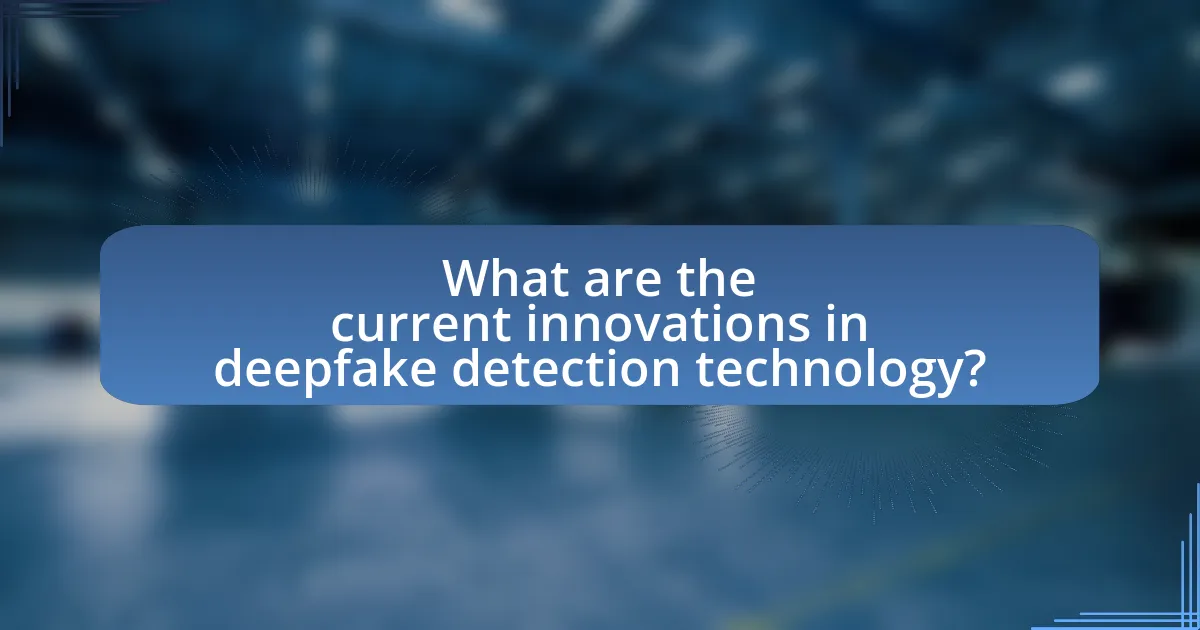
What are the current innovations in deepfake detection technology?
Current innovations in deepfake detection technology include the use of advanced machine learning algorithms, particularly convolutional neural networks (CNNs), which enhance the accuracy of identifying manipulated media. Researchers have developed models that analyze facial movements, inconsistencies in lighting, and audio-visual synchronization to detect deepfakes more effectively. For instance, a study published in 2023 by the University of California, Berkeley, demonstrated a new detection framework that achieved over 95% accuracy in distinguishing deepfakes from authentic videos by leveraging temporal analysis of facial expressions. Additionally, the integration of blockchain technology for verifying the authenticity of video content is emerging as a promising approach, providing a decentralized method to trace the origin of media files.
How do machine learning and AI contribute to deepfake detection?
Machine learning and AI significantly enhance deepfake detection by employing algorithms that analyze patterns and inconsistencies in digital media. These technologies utilize techniques such as convolutional neural networks (CNNs) to identify subtle artifacts and anomalies that are often present in manipulated videos or images. For instance, a study published in the journal “Nature” demonstrated that AI models could achieve over 90% accuracy in distinguishing between real and deepfake videos by examining facial movements and pixel-level discrepancies. This capability allows for the rapid identification of deepfakes, thereby addressing ethical concerns related to misinformation and digital manipulation.
What algorithms are most effective in identifying deepfakes?
Convolutional Neural Networks (CNNs) are among the most effective algorithms for identifying deepfakes. CNNs excel in analyzing visual data, allowing them to detect subtle inconsistencies in facial features and movements that may indicate manipulation. Research has shown that CNN-based models, such as XceptionNet and EfficientNet, achieve high accuracy rates in distinguishing between real and fake images, with some studies reporting accuracy levels exceeding 90%. Additionally, recurrent neural networks (RNNs) and generative adversarial networks (GANs) have also been utilized in deepfake detection, enhancing the ability to identify temporal inconsistencies in video content.
How do these technologies evolve to counteract new deepfake techniques?
Technologies evolve to counteract new deepfake techniques by implementing advanced machine learning algorithms and real-time detection systems. These systems utilize deep neural networks trained on vast datasets of authentic and manipulated media to identify subtle inconsistencies in deepfake content, such as unnatural facial movements or audio mismatches. For instance, researchers at the University of California, Berkeley developed a deepfake detection tool that achieved over 90% accuracy in identifying manipulated videos by analyzing pixel-level changes. Additionally, ongoing research focuses on creating adaptive models that continuously learn from emerging deepfake techniques, ensuring that detection methods remain effective as new manipulation strategies are developed.
What role do researchers and developers play in this innovation?
Researchers and developers play a critical role in the innovation of deepfake detection by creating algorithms and technologies that identify manipulated media. Their work involves analyzing patterns in deepfake content, developing machine learning models, and refining detection techniques to enhance accuracy. For instance, researchers at the University of California, Berkeley, have developed a deep learning framework that can detect deepfakes with over 90% accuracy, demonstrating the effectiveness of their innovations in this field. Additionally, developers implement these algorithms into user-friendly applications, ensuring that the technology is accessible for widespread use in combating misinformation and protecting ethical standards in media.
How can collaboration enhance the effectiveness of deepfake detection tools?
Collaboration can enhance the effectiveness of deepfake detection tools by pooling resources, expertise, and data from multiple stakeholders, including researchers, technology companies, and regulatory bodies. This collective effort allows for the development of more sophisticated algorithms that can better identify deepfakes, as diverse perspectives contribute to a more comprehensive understanding of the evolving techniques used in creating such content. For instance, collaborative initiatives like the Deepfake Detection Challenge have demonstrated that shared datasets and benchmarks can significantly improve detection accuracy, as participants learn from each other’s methodologies and findings.
What ethical responsibilities do developers have in creating detection technologies?
Developers have the ethical responsibility to ensure that detection technologies are accurate, transparent, and respect user privacy. This responsibility includes creating algorithms that minimize bias and prevent misuse, as evidenced by studies showing that biased algorithms can lead to discriminatory outcomes. Furthermore, developers must provide clear information about how these technologies work and their limitations, as transparency fosters trust and accountability. Ethical guidelines, such as those proposed by the IEEE Global Initiative on Ethics of Autonomous and Intelligent Systems, emphasize the importance of human oversight and the need to prioritize societal well-being in technology development.

How can ethical considerations be integrated into deepfake detection practices?
Ethical considerations can be integrated into deepfake detection practices by establishing clear guidelines that prioritize transparency, accountability, and user consent. These guidelines should ensure that detection technologies are developed and deployed with an emphasis on protecting individuals’ rights and privacy. For instance, organizations can implement protocols that require explicit consent from individuals whose likenesses may be used in deepfake content, thereby respecting personal autonomy. Additionally, incorporating diverse stakeholder perspectives, including ethicists, technologists, and affected communities, can help identify potential biases and ethical dilemmas in detection algorithms. Research indicates that ethical frameworks in technology development lead to more socially responsible outcomes, as seen in the work by Jobin, Ienca, and Andorno (2019) in “The Global Landscape of AI Ethics Guidelines,” which highlights the importance of ethical considerations in technology to foster trust and societal acceptance.
What frameworks exist for ethical decision-making in technology?
Several frameworks exist for ethical decision-making in technology, including the Ethical Guidelines for Trustworthy AI by the European Commission, the IEEE Global Initiative on Ethics of Autonomous and Intelligent Systems, and the ACM Code of Ethics. These frameworks provide structured approaches to evaluate the ethical implications of technology, emphasizing principles such as transparency, accountability, and fairness. For instance, the Ethical Guidelines for Trustworthy AI outlines seven key requirements, including human oversight and robustness, which aim to ensure that AI technologies are developed and deployed responsibly.
How can these frameworks be applied to deepfake detection?
Frameworks can be applied to deepfake detection by utilizing machine learning algorithms and ethical guidelines to enhance accuracy and accountability. Machine learning frameworks, such as convolutional neural networks (CNNs), can analyze visual and auditory patterns in media to identify inconsistencies indicative of deepfakes. For instance, a study by Korshunov and Marcel (2018) demonstrated that CNNs could achieve over 90% accuracy in detecting manipulated videos. Ethical frameworks ensure that the deployment of these technologies respects privacy and consent, addressing potential misuse. By integrating technical capabilities with ethical considerations, these frameworks can effectively combat the challenges posed by deepfakes while promoting responsible innovation.
What role does transparency play in ethical deepfake detection?
Transparency is crucial in ethical deepfake detection as it fosters trust and accountability in the technology’s use. By providing clear information about the algorithms, data sources, and methodologies employed in deepfake detection, stakeholders can better understand the limitations and potential biases of the technology. For instance, research indicates that transparency can enhance user confidence and promote responsible usage, as seen in studies where users were more likely to accept detection outcomes when they understood the underlying processes. This understanding helps mitigate the risks of misinformation and misuse associated with deepfakes, thereby reinforcing ethical standards in the field.
What best practices can organizations adopt for ethical deepfake detection?
Organizations can adopt several best practices for ethical deepfake detection, including implementing robust detection technologies, establishing clear ethical guidelines, and promoting transparency in their processes. Utilizing advanced machine learning algorithms can enhance the accuracy of identifying deepfakes, as evidenced by research from the University of California, Berkeley, which highlights the effectiveness of AI-based detection methods. Additionally, organizations should create ethical frameworks that outline acceptable use cases for deepfake technology, ensuring that all stakeholders understand the implications of its use. Transparency in the detection process, such as disclosing the methods and technologies used, fosters trust and accountability, aligning with ethical standards in technology deployment.
How can organizations ensure compliance with ethical standards?
Organizations can ensure compliance with ethical standards by implementing comprehensive ethical guidelines and training programs. Establishing a clear code of ethics that outlines acceptable behaviors and decision-making processes is essential. Regular training sessions for employees on ethical practices, particularly in areas like deepfake detection, reinforce the importance of ethical considerations. Additionally, organizations should conduct regular audits and assessments to evaluate adherence to these standards, ensuring accountability and transparency. Research indicates that companies with strong ethical cultures experience fewer legal issues and enhanced reputations, demonstrating the effectiveness of these measures in maintaining compliance.
What training and resources are necessary for ethical deepfake detection?
Ethical deepfake detection requires specialized training in machine learning, computer vision, and digital forensics, along with access to datasets of both genuine and manipulated media. Training programs should focus on understanding the underlying algorithms used in deepfake creation, as well as the ethical implications of their use. Resources such as the Deepfake Detection Challenge dataset, which includes a variety of deepfake videos, provide essential material for developing and testing detection algorithms. Additionally, collaboration with interdisciplinary teams, including ethicists and legal experts, is crucial to address the broader implications of deepfake technology.
What are the future implications of balancing innovation and ethics in deepfake detection?
Balancing innovation and ethics in deepfake detection will lead to enhanced technological advancements while ensuring responsible use of such technologies. As detection methods improve, they will likely become more sophisticated, enabling quicker identification of deepfakes, which can mitigate misinformation and protect individuals’ reputations. However, ethical considerations, such as privacy rights and the potential for misuse of detection technologies, must be integrated into development processes. For instance, the implementation of ethical guidelines can prevent the exploitation of detection tools for surveillance or censorship, thereby fostering public trust. The future landscape will require collaboration between technologists, ethicists, and policymakers to create frameworks that support innovation while safeguarding societal values.
How might evolving technologies impact ethical considerations in the future?
Evolving technologies will significantly impact ethical considerations in the future by introducing complex dilemmas surrounding privacy, consent, and misinformation. As advancements in artificial intelligence and deepfake technology continue, the potential for misuse increases, leading to ethical challenges regarding the authenticity of digital content. For instance, a study by the University of California, Berkeley, highlights that deepfake technology can create highly realistic but misleading videos, raising concerns about the erosion of trust in media. This technological evolution necessitates the development of robust ethical frameworks to address issues such as accountability for creators and the protection of individuals’ rights, ensuring that innovation does not compromise societal values.
What proactive measures can be taken to address future challenges?
Proactive measures to address future challenges in deepfake detection include developing robust detection algorithms, implementing regulatory frameworks, and fostering public awareness. Developing advanced algorithms that utilize machine learning can enhance the accuracy of identifying deepfakes, as evidenced by research from the University of California, Berkeley, which demonstrated a 95% detection rate using deep learning techniques. Implementing regulatory frameworks can establish guidelines for ethical use and accountability, as seen in the European Union’s proposed regulations on AI, which aim to mitigate risks associated with deepfake technology. Additionally, fostering public awareness through educational campaigns can empower individuals to critically assess media authenticity, thereby reducing the impact of misinformation.
